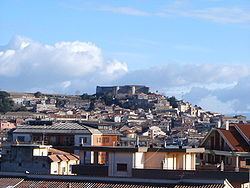Province / Metropolitan city Vibo Valentia (VV) Demonym(s) Vibonesi | Elevation 476 m (1,562 ft) Area 46.2 km² Local time Sunday 9:40 PM | |
 | ||
Frazioni Bivona, Longobardi, Piscopio, Porto Salvo, San Pietro, Vena Inferiore, Vena Media, Vena Superiore, Triparni, Vibo Marina Weather 7°C, Wind S at 10 km/h, 99% Humidity Points of interest State Archaeological Museum "Vito Capialbi", Scavi Villa Romana, Tempio Greco (Resti) | ||
Vibo Valentia ([ˈviːbo vaˈlɛntsja]) is a city and comune (municipality) in the Calabria region of southern Italy, near the Tyrrhenian Sea. It is the capital of the province of Vibo Valentia, and is an agricultural, commercial and tourist center (the most famous places nearby are Tropea, Ricadi and Pizzo). There are also several large manufacturing industries, including the tuna district of Maierato. Very important for the local economy is Vibo Marina's harbour.
Contents
- Map of 89900 Vibo Valentia Province of Vibo Valentia Italy
- History
- Bishopric
- Main sights
- Twin towns
- References
Map of 89900 Vibo Valentia, Province of Vibo Valentia, Italy
History
Vibo Valentia was originally the Greek colony of Hipponion. It was founded, probably around the late 7th century BC, by inhabitants of Locri, a principal city of the Italian Magna Graecia, south of Vibo Valentia on the Ionian Sea. Diodorus Siculus reports that the city was taken in 388 BC by Dionysius the Elder tyrant of Syracuse, who deported all the population. The population came back in 378 BC, with the help of the Carthaginians. In the following years Hipponion came under the dominion of the Bruttii, who controlled most of Calabria. After the town fell to Rome, the name was Latinized to Hipponium. The town became a Roman colony in 194 BC with the name of Vibo Valentia. After a phase of prosperity during the late Republic and early Empire, the town was almost completely abandoned after the fall of the Western Roman Empire.
In 1070 the Normans built a castle at the site of the old Acropolis and in 1235 a new city was established by Frederick II, Holy Roman emperor and king of Sicily, with the name of Monteleone. The city got back the old Roman name of Vibo Valentia only in 1928.
Bishopric
A Diocese of Vibo Valentia was established in 451AD and suppressed in 1083AD when it was incorporated into the Diocese of Mileto. In 1968AD it was restored as a Titular See and it remains a titular see of the Roman Catholic Church. The only known bishops are:
